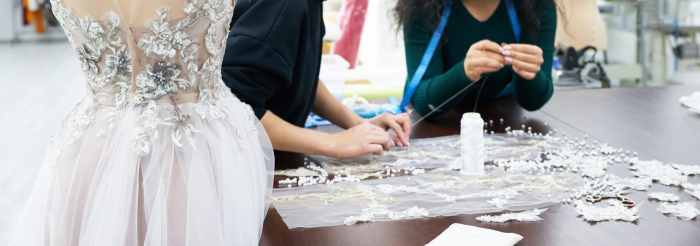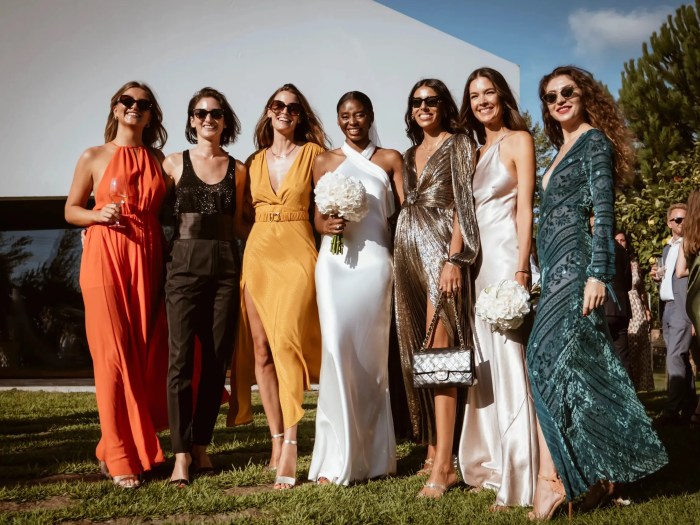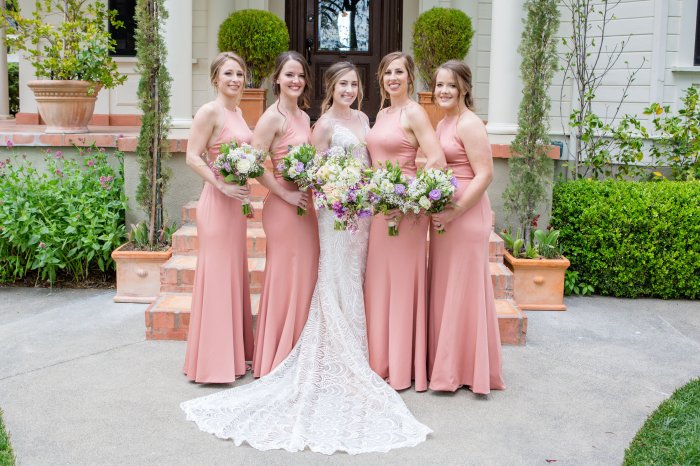Fabric Selection for a Wedding Dress: How To Make A Wedding Dress
How to make a wedding dress – Choosing the right fabric is paramount in creating a wedding dress that is both beautiful and comfortable. The fabric significantly impacts the drape, texture, and overall feel of the gown, influencing its suitability for different styles and seasons. This section explores various fabrics, their properties, and how to select the ideal one for your wedding.
Fabric Properties and Comparisons
Several fabrics are commonly used in wedding dress construction, each possessing unique characteristics. The following table compares key features to aid in your selection.
| Fabric | Drape | Texture | Cost | Suitability |
|---|---|---|---|---|
| Silk | Excellent, flows beautifully | Smooth, luxurious | High | Formal, elegant styles; all seasons (with layering for colder months) |
| Satin | Good, smooth drape | Smooth, lustrous | Medium-High | Classic, sleek styles; suitable for most seasons |
| Lace | Depends on the type; can be stiff or flowy | Delicate, intricate | Medium-High | Romantic, detailed styles; best for warmer months or as an overlay |
| Tulle | Fair, stiff but can be layered for volume | Net-like, sheer | Low-Medium | Romantic, voluminous styles; often used for skirts and overlays |
Fabric Selection Based on Wedding Factors
Consider your wedding’s theme, season, and your body type when selecting fabric. A summer wedding might call for lightweight fabrics like cotton or silk organza, while a winter wedding might benefit from heavier fabrics like velvet or brocade. Your body type also influences fabric choice; flowing fabrics can flatter curvier figures, while structured fabrics can create a more defined silhouette for slimmer figures.
Examples of Fabrics in Wedding Dress Designs

Source: josabimariees.com
Silk charmeuse is often used for classic, elegant sheath gowns, showcasing its luxurious drape and subtle sheen. Lace is frequently incorporated into romantic ball gowns, adding intricate detailing and texture. Tulle is a popular choice for creating voluminous skirts in princess-style dresses.
Designing the Wedding Dress Pattern
Creating a wedding dress pattern requires understanding the fundamental elements: bodice, skirt, and sleeves. Accurate measurements and adjustments are crucial for a perfect fit. This section Artikels the process of designing a basic pattern and adapting it to different body types.
Basic Bodice and Skirt Patterns
A basic bodice pattern involves taking measurements for bust, waist, and shoulder width. These measurements inform the creation of the pattern pieces. Similarly, a simple A-line skirt pattern requires measuring the waist circumference and desired skirt length. These measurements are used to create a basic pattern that can be adjusted for individual fit.
Adjusting Patterns for Different Body Shapes
Adjusting a standard pattern requires careful consideration of bust, waist, and hip measurements. For example, a full bust might require adding fullness to the bodice pattern pieces, while a larger waist might necessitate adjustments to the skirt pattern to ensure a comfortable fit. Detailed instructions and diagrams are essential for accurate alterations.
Sewing Techniques for Wedding Dresses
Mastering key sewing techniques is essential for constructing a professional-looking wedding dress. This section details crucial techniques, comparing hand-sewing and machine sewing methods.
Essential Sewing Techniques
Gathering, pleating, and French seams are fundamental techniques used in wedding dress construction. Gathering creates fullness in fabric, pleating adds structured folds, and French seams provide a clean, professional finish. Detailed instructions, including diagrams, are essential for mastering these techniques.
- Gathering: Evenly distributing gathers to create fullness in skirts or sleeves.
- Pleating: Creating precise, uniform folds in fabric for structured details.
- French Seams: Enclosing raw edges for a clean, durable finish.
Attaching Lace Appliqués
Attaching lace appliqués requires careful consideration of the stitching method to ensure a secure and aesthetically pleasing result. Hand-sewing allows for greater precision and control, while machine sewing offers speed and efficiency. The choice depends on the complexity of the design and the desired level of detail.
Hand-Sewing vs. Machine Sewing
Hand-sewing offers precision and control, particularly for delicate fabrics and intricate details. Machine sewing provides speed and efficiency for larger areas of construction. A combination of both methods is often used for optimal results.
Constructing the Wedding Dress Bodice
Constructing a fitted bodice involves shaping and supporting the bust for a flattering silhouette. This section details the process, including creating different neckline styles and incorporating boning for structure.
Constructing a Fitted Bodice
Creating a fitted bodice begins with accurate pattern construction and careful fabric cutting. Techniques for shaping and supporting the bust include using darts, seams, and boning. Detailed instructions, including diagrams, are essential for achieving a well-fitted bodice.
Creating Different Neckline Styles
- Sweetheart Neckline: A curved neckline that follows the shape of the bust.
- V-Neck Neckline: A V-shaped neckline that elongates the torso.
- Halter Neckline: A neckline that ties or fastens behind the neck.
Bodice with Boning
Boning provides structure and support to the bodice, preventing sagging and maintaining the desired shape. The placement and type of boning (plastic or spiral steel) depend on the design and the level of support required. Precise placement is crucial for optimal support and comfort.
Creating the Wedding Dress Skirt

Source: vogue.com
Constructing different skirt styles requires understanding the techniques for creating fullness, shaping, and fitting. This section Artikels the process for creating various skirt styles.
Creating a wedding dress involves meticulous planning and skillful execution, from pattern drafting to intricate embellishments. However, if you’re attending a wedding and prefer a ready-to-wear option, consider the stylish and contemporary designs offered by browsing house of cb wedding guest dresses ; their selection provides inspiration for potential design elements in your own creation. Returning to the process of making a wedding dress, remember that fabric selection is key to achieving the desired look and feel.
Constructing Different Skirt Styles
A-line, ball gown, and mermaid skirts each require different construction techniques. An A-line skirt is relatively straightforward, while a ball gown requires creating significant volume. A mermaid skirt requires precise fitting and shaping to create the dramatic silhouette.
Creating a Full, Gathered Skirt
A full, gathered skirt is created by gathering multiple layers of fabric to achieve the desired volume. Even distribution of gathers is crucial for a smooth, even look. Techniques for managing the bulk of fabric are essential for preventing puckering or unevenness.
Creating a Fitted Skirt
A fitted skirt utilizes darts and seams to shape the fabric to the body. Precise placement of darts and careful seam construction are crucial for a smooth, well-fitting skirt.
Finishing Touches and Details
Adding embellishments and creating a professional finish elevates the wedding dress to a masterpiece. This section covers embellishment techniques and finishing details.
Adding Embellishments, How to make a wedding dress
Beading, embroidery, and sequins add sparkle and texture to a wedding dress. Careful placement and secure attachment are essential to prevent damage or loss of embellishments. The type of embellishment should complement the overall style of the dress.
Creating a Professional Finish
Hemming the dress and finishing seams are crucial for a clean, professional look. Techniques for hemming include blind hemming and machine hemming. Seam finishes, such as serging or zigzag stitching, prevent fraying and add durability.
Unique Embellishment Design
A unique embellishment could be a hand-embroidered floral motif using metallic threads on the bodice. This involves sketching the design, transferring it to the fabric, and carefully stitching the design using various embroidery stitches to create texture and depth. The use of metallic threads adds a touch of glamour and sophistication.
Understanding Different Wedding Dress Silhouettes
Wedding dress silhouettes significantly impact the overall look and how the dress flatters the bride’s body type. This section compares and contrasts various silhouettes.
Wedding Dress Silhouette Comparison
Different silhouettes, such as empire waist, sheath, and ballgown, each have unique characteristics and suit different body types. The following table summarizes these features.
| Silhouette | Characteristics | Best Suited For | Fabric Considerations |
|---|---|---|---|
| Empire Waist | Fitted bodice just below the bust, flowing skirt | Most body types, especially those wanting to emphasize the upper body | Lightweight, flowing fabrics |
| Sheath | Fitted from shoulders to hem | Slim to average body types | Structured fabrics with good drape |
| Ballgown | Fitted bodice, full skirt | Most body types, especially those wanting to create volume | Lightweight to medium-weight fabrics, often layered for fullness |
Key Design Elements of Silhouettes
The key design elements defining each silhouette include the waistline placement, skirt fullness, and overall fit. These elements work together to create the distinctive shape of each style.
Fabric and Construction’s Influence on Silhouette

Source: squarespace-cdn.com
The choice of fabric and construction techniques significantly impact the final silhouette. Lightweight fabrics create a softer, more flowing silhouette, while structured fabrics create a more defined shape. Seams, darts, and other construction techniques also contribute to the overall silhouette.
Answers to Common Questions
What sewing machine is best for making a wedding dress?
A heavy-duty sewing machine with a variety of stitch options, including a blind hem stitch, is ideal. Consider machines with adjustable presser foot pressure for handling different fabrics.
How much fabric do I need for a wedding dress?
Fabric requirements vary greatly depending on the dress design and size. Always add extra for potential mistakes and pattern matching. Consult your pattern instructions for specific yardage requirements.
How long does it take to make a wedding dress?
The timeframe depends on your sewing experience and the complexity of the design. Expect to invest significant time – several weeks or even months – for a meticulously crafted gown.
Where can I find affordable wedding dress fabrics?
Online fabric retailers, local fabric stores, and even thrift stores can be excellent sources for affordable wedding dress fabrics. Consider using less expensive fabrics for lining or underlayers.
